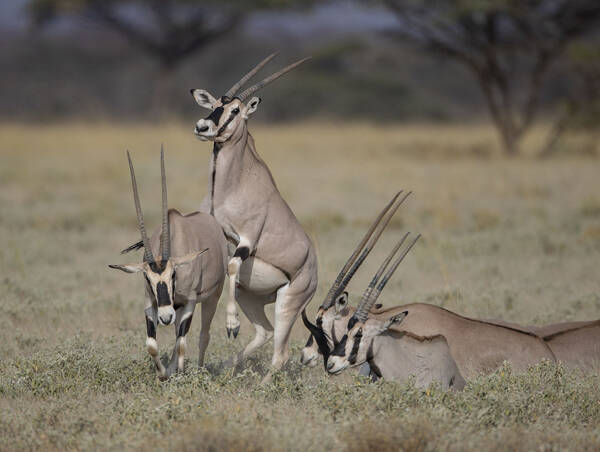Oryx beisa
IUCN
LCBasic Information
Scientific classification
- name:Oryx beisa
- Scientific Name:East African Gemsbok, Oryx oryx, East African Gemsbok
- Outline:Ungulata
- Family:Artiodactyla Bovidae Oryx
Vital signs
- length:160-190cm
- Weight:150-200kg
- lifetime:About 18 years
Feature
There is no black area on the hind legs, and the black markings only extend to the abdomen
Distribution and Habitat
Origin: Djibouti, Ethiopia, Kenya, Somalia, South Sudan, United Republic of Tanzania.
Possibly extinct: Eritrea, Sudan, Uganda.
The East African Oryx lives at altitudes from sea level to 1,700 meters. In semi-deserts and sandy areas, it is very drought-tolerant. It prefers arid and semi-arid jungles and grasslands. Grazing conditions and soil conditions affect seasonal migration.
Appearance
The East African Oryx has a body length of 160-190 cm, a height of 110-120 cm, a tail length of 70-80 cm, and a weight of 150-200 kg. The horns are thin, straight, and slightly curved. They are found in both male and female antelopes, and are generally 75-80 cm long. The fur is gray and the belly is white. There is a black mark dividing the white and gray. There are also black marks between the head and neck, along the nose, from the eyes to the mouth and on the forehead. They have a small, chestnut-colored mane. The erect hairs on the back are shallower and narrower. The most significant difference is that the East African Oryx has no black areas on its hind legs, and the black markings extend to its abdomen; while the South African Oryx has large black patches on its hind legs. Black hair is distributed in the center of the face, around the eyes to the mouth, the pharynx, the sides between the forelimbs and hindlimbs, the shins of the limbs and the tail.
Details
East African Oryx (scientific name: Oryx beisa) English Beisa Oryx, French Oryx Beisa, German Eritrea-Spiessbock, Somali Be'id, Swahili Choroa, there are 2 subspecies.

The East African Oryx has evolved a variety of physiological characteristics to adapt to the desert environment due to its long-term living in a hot and dry environment. When it lacks water, it can go without drinking for several days. In order to retain the precious water in its body, it can raise its body temperature from 35.7℃ to 45℃, a temperature that would surely kill other mammals, reducing the temperature difference between the body and the outside world and reducing the absorption of heat to a certain extent. Very well adapted to living in the desert.
The Oryx herds are about 6-40 members, with females usually leading the herd and larger males protecting them from behind. The herds of this species have a clear hierarchy, with a female leading the herd and a "Oryx male" leading the pack. However, if the leading female deviates from the set route, the male will rush to the front and change the direction of the march. Some older males are solitary. Radio tracking has found that solitary males sometimes live with females in estrus for a short period of time to increase the chances of reproduction. When threatened, they usually flee, but when cornered, they will show brave defense, sometimes using their spear-like horns to cause fatal damage to opponents.

The East African Oryx feeds on grass, leaves, buds and fruits of plants, eating more grass during the grass seed growth stage and the dry season. They drink water regularly and can rely on water-storing melons, rhizomes, bulbs and tubers to maintain the water content in the body and increase body temperature. They will tirelessly dig these plants with high water content.
The gestation period of the East African Oryx is 8.5-10 months. The average litter is one calf, and the weaning period is an average of 3.5 months later. Females reach sexual maturity at 1.5-2 years old, and males at 5 years old. The life span is up to 18 years. Although synchronous births have been reported, breeding can occur year-round. After the calf is born, it is hidden by the female in the grass for 2-6 weeks before being brought into the herd by the female.
The East African Oryx is listed as endangered under the IUCN standard A2bd because the population has decreased from 34,000 in the mid-1990s to about 16,000-18,000 in 18 years (three generations), an estimated decrease of 52% (49-55%).
Listed in the IUCN Red List of Threatened Species in 2018 ver3.1 - Endangered (EN).
Protect wild animals and eliminate game.
Maintaining ecological balance is everyone's responsibility!








